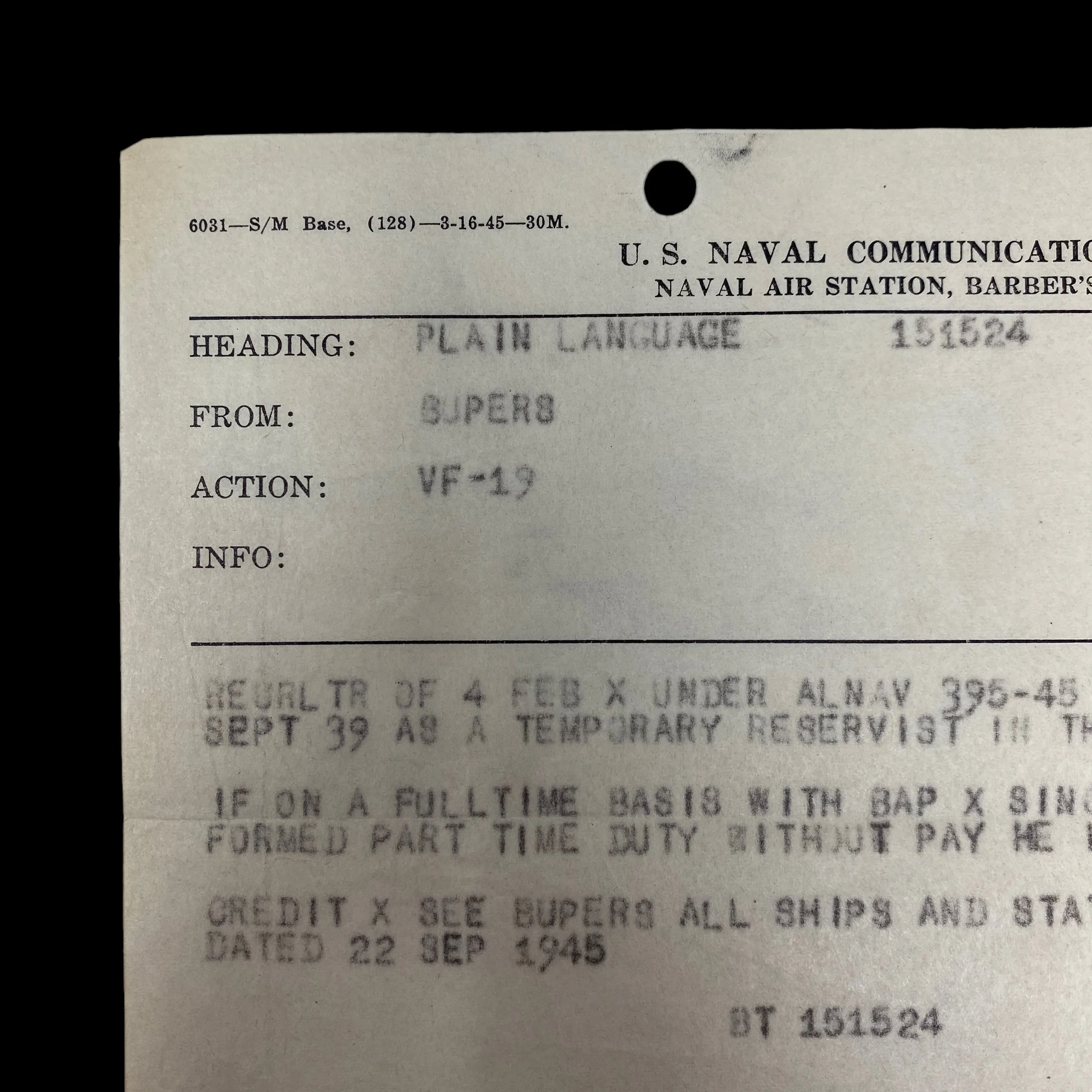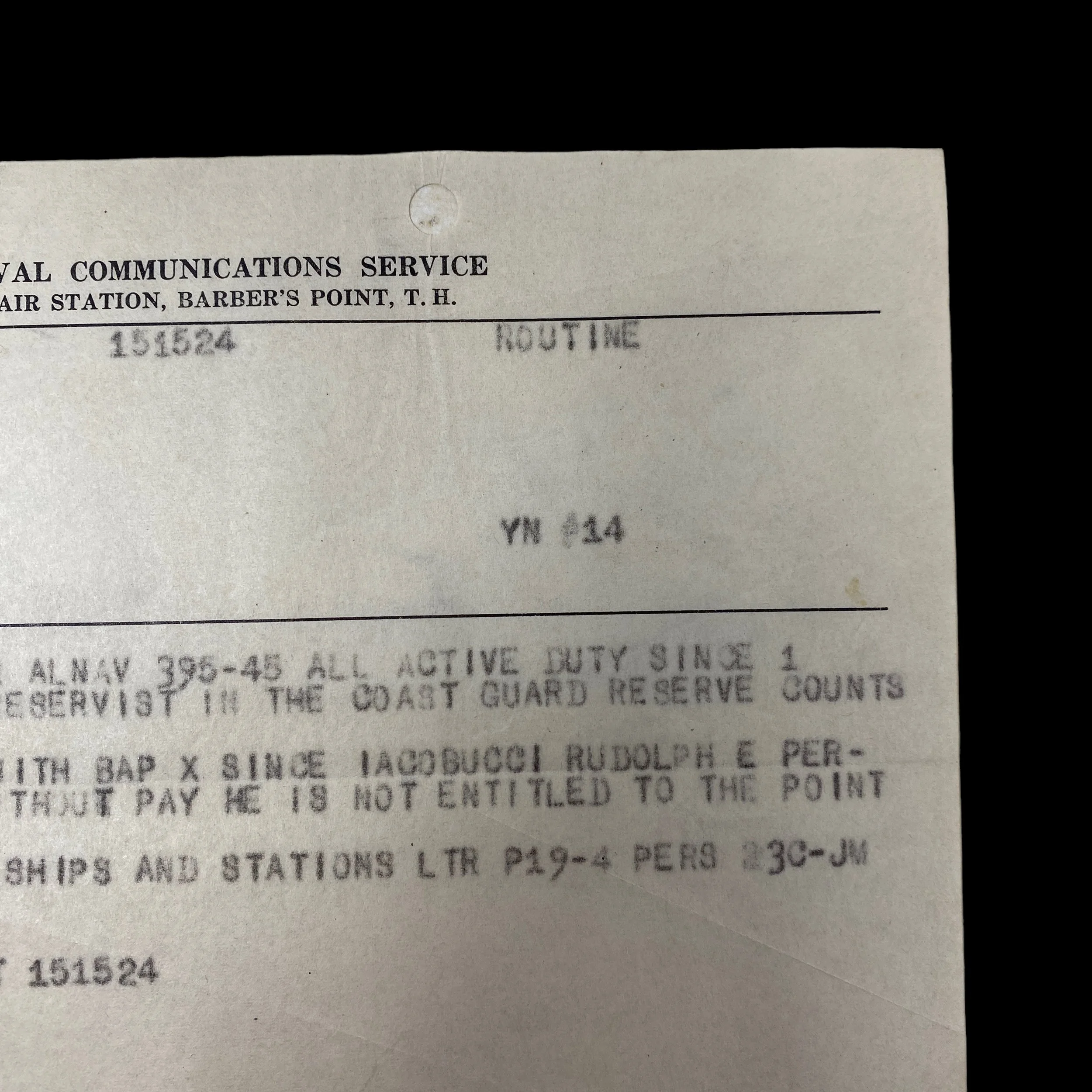Post WWII 1946 USS Hornet U.S. Navy Communications Sheet*








Post WWII 1946 USS Hornet U.S. Navy Communications Sheet*
Comes with C.O.A.
This is a post-WWII 1946 USS Hornet USN communications document.
After the war the USS Hornet took part in Operation Magic Carpet, returning troops to the U.S. and was then placed in reserve in 1946. Hornet was reactivated during the Korean War of 1950–1953, but spent the rest of the war being modernized to allow her to operate jet-propelled aircraft. The ship was modernized again in the late 1950s for service as an anti-submarine carrier. She played a minor role in the Vietnam War during the 1960s and in the Apollo program, recovering the Apollo 11 and Apollo 12 astronauts when they returned from the Moon.
USS Hornet WWII Campaign History:
USS Hornet CV-12 is an Essex-class aircraft carrier built for the United States Navy (USN) during World War II. Completed in late 1943, the ship was assigned to the Fast Carrier Task Force (variously designated as Task Force 38 or 58) in the Pacific Ocean, the navy's primary offensive force during the Pacific War. The USS Hornet CV-12 had a distinguished World War II career that included the invasion of Saipan and the Battle of the Philippine Sea, the amphibious landing on Palau, the Philippines, Iwo Jima and Okinawa and strikes against the Japanese home islands. The USS Hornet and its air groups were credited with shooting down 688 planes, destroying another 742 aircraft on the ground, sinking a carrier, cruiser, 42 cargo ships and 10 destroyers and assisting in the sinking of the Japanese battleship Yamato. The Hornet received seven battle stars and the Presidential Unit Citation during World War II.
In 18 months of combat operations, USS Hornet CV-12 achieved the following combat record:
668 Japanese planes shot down
742 Japanese planes were destroyed on the ground
1,269,710 tons of enemy ships sunk or heavily damaged: 73 ships sunk, 37 probable, 413 damaged
Ship’s engines burned 28,437,630 gallons of fuel oil
Ship’s evaporators distilled 41,231,453 gallons of freshwater
The ship steamed 155,000 miles (equal to six trips around the world.
Air Wings:
Aircraft burned 5,644,800 gallons of aviation gasoline
Aircraft fired 4,878,748 rounds of machine-gun bullets
Aircraft delivered 17,793 bombs, 5,842 rockets, and 116 torpedoes
Aircraft flew 18,569 combat sorties
Aircraft logged over 23,000 arrested landings
Ship’s Guns:
Fired 7,275 rounds of 5″ ammo
Fired 115,179 rounds of 40 mm ammo
Fired 409,580 rounds of 20 mm ammo
1 carrier sunk, 1 cruiser sunk, 10 destroyers sunk, 42 cargo ships sunk and assisted in the sinking of the IJN super battleship Yamato.
USS Hornet (CV-12) was awarded nine Battle Stars for Pacific service in World War II:
One Star — Asiatic-Pacific Raids – 1944
One Star — Hollandia Operation – 1944
One Star — Marianas Operation – 1944
One Star — Western Caroline Islands Operation – 1944
One Star — Western New Guinea Operation – 1944
One Star — Leyte Operation – 1944
One Star — Luzon Operation – 1944-1945
One Star — Iwo Jima Operation – 1945
One Star — Okinawa Gunto Operation – 1945
USS Hornet (CV-12) was awarded a Presidential Unit Citation for the following operations:
Air Group 2 (VF-2, VB-2, VT-2, and part of VFN-76)
March 29 – May 1, 1944 — Palau, Hollandia, Truk.
June 11 – August 5, 1944 — Marianas, Bonins, Yap.
September 6 – September 24, 1944 — Philippines, Palau.
Air Group 11 (VF-11, VB-11, and VT-11)
October 10 – Nov. 22, 1944 — Ryukyus, Formosa, Philippines, Luzon.
December 14 – Dec. 16, 1944 — Luzon.
January 3 – January 22, 1945 — Philippines, Formosa, China Sea, Ryukyus.
Air Group 17 (VF-17, VBF-17, VB-17, and VT-17)
February 16 – June 10, 1945 — Japan, Bonins, Ryuky